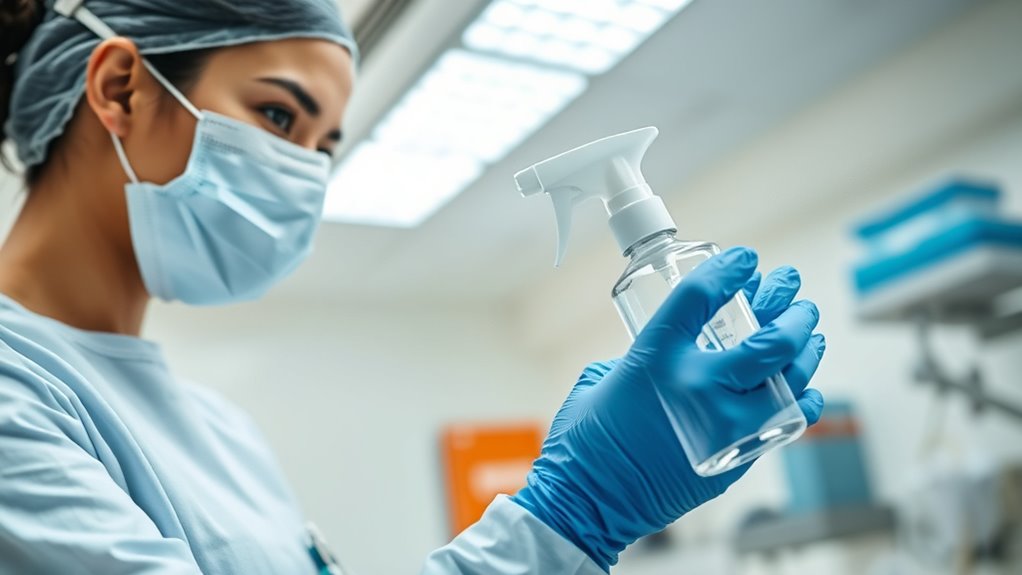To practice effective infection control and hygiene, you should wash your hands thoroughly before and after patient contact, using proper techniques like scrubbing for at least 20 seconds. Always wear and dispose of PPE correctly, and keep the environment clean by disinfecting surfaces regularly. Proper waste disposal and recognizing infection risks are essential to prevent outbreaks. Keeping these habits consistent helps protect everyone, and exploring more will give you a deeper understanding of best practices.
Key Takeaways
- Practice proper hand hygiene by washing with soap and water or using alcohol-based sanitizer before and after patient contact.
- Wear appropriate PPE for each task, and dispose of it correctly to prevent contamination.
- Regularly disinfect surfaces, high-touch areas, and medical equipment to maintain a sanitized environment.
- Segregate waste properly, using designated containers and biohazard symbols for infectious materials.
- Educate patients and families on hygiene practices, emphasizing routine handwashing and infection prevention measures.
Importance of Hand Hygiene
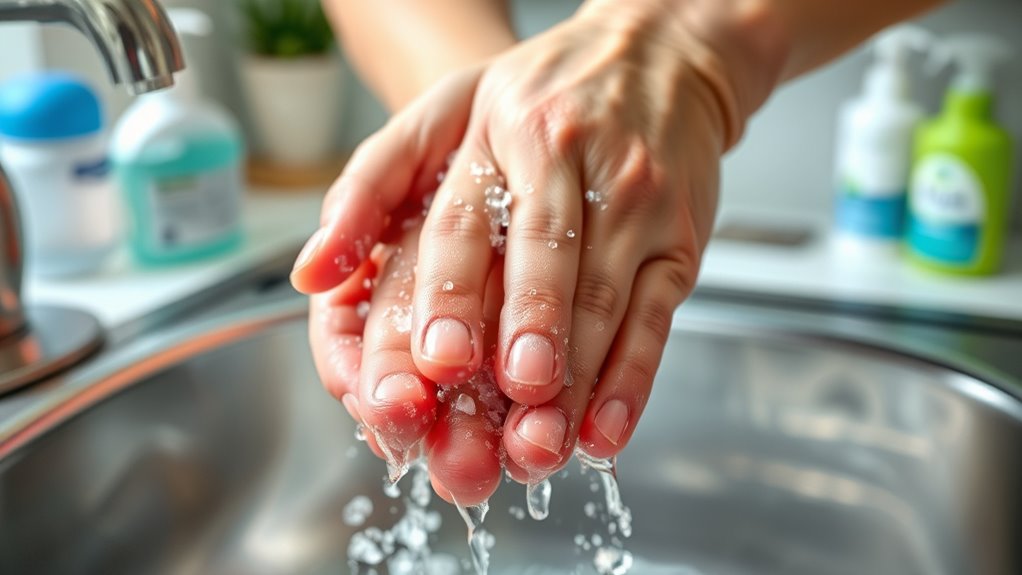
Hand hygiene is your most effective defense against the spread of infections. By practicing good hand hygiene, you considerably reduce the risk of transmitting harmful germs to your patients or loved ones. Proper hand hygiene is a vital step in infection prevention, helping to stop the transfer of bacteria and viruses from surfaces or hands to vulnerable individuals. When you wash or sanitize your hands regularly, you create a safer environment for everyone. Neglecting hand hygiene can lead to outbreaks of infections that might have been easily prevented. Remember, your hands are the primary vehicle for germs, so maintaining clean hands is a simple yet powerful way to protect yourself and those in your care. Consistent hand hygiene is essential for effective infection prevention. Using proper handwashing techniques ensures the removal of germs more effectively than partial cleaning. Incorporating hand sanitizer with at least 60% alcohol can provide additional protection when soap and water are not readily available. Regular hand hygiene also supports infection control protocols that are critical in healthcare settings. Additionally, understanding the role of healthcare workers in infection control emphasizes the importance of diligent hand hygiene practices. Maintaining hand hygiene compliance across all caregiving situations is crucial to reducing transmission risks.
Proper Techniques for Handwashing
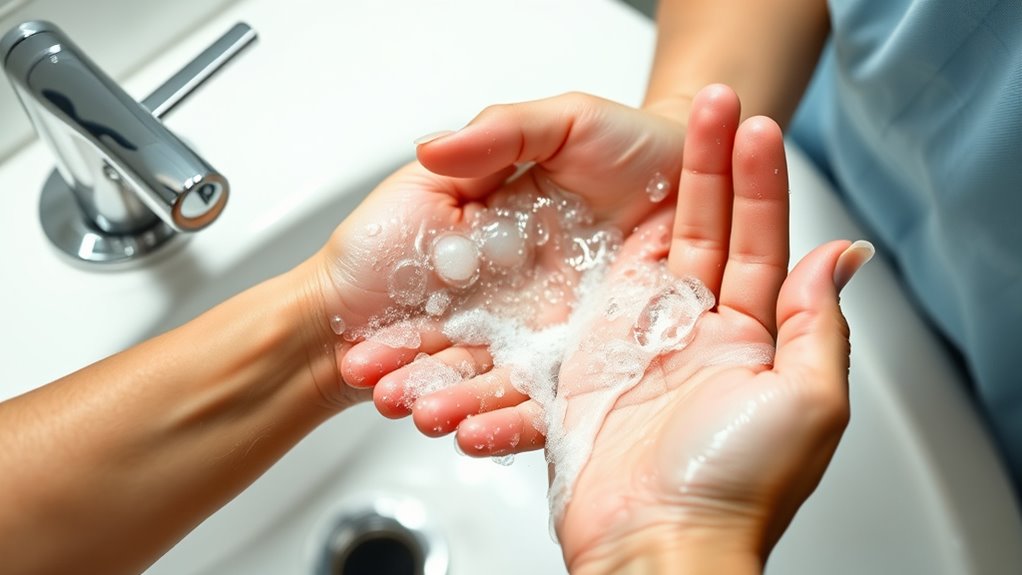
To effectively prevent the spread of germs, you need to follow the correct handwashing steps every time. Knowing when to wash your hands, such as before and after patient contact, is just as important as doing it properly. By mastering these techniques, you help protect both yourself and those in your care. Additionally, ensuring that your air quality is maintained can further reduce the risk of airborne infections. Using an appropriate air purifier can help eliminate airborne pathogens and improve overall hygiene in your environment. Regular cleaning and proper storage of essential oils can also support a healthier setting by reducing microbial contamination. Incorporating disposable gloves into your routine when necessary can provide an extra layer of protection against transmission of infectious agents.
Correct Handwashing Steps
Proper handwashing is essential for preventing the spread of infections, especially when caring for vulnerable individuals. Start by wetting your hands with clean, running water and apply enough soap to cover all surfaces. Scrub your hands thoroughly, paying attention to the backs, between fingers, and under nails, for at least 20 seconds. Rinse well with water to remove germs and soap residue. If soap and water aren’t available, use an alcohol-based hand sanitizer containing at least 60% alcohol, ensuring you cover all surfaces until dry. Proper hand drying is vital; use a clean towel or air dry your hands completely to prevent bacteria transfer. Hand hygiene practices are proven to be highly effective in reducing infection transmission. Follow these steps consistently to maximize hand hygiene and reduce infection risk effectively.
When to Wash Hands
Washing your hands at the right times is essential to stopping the spread of infections. Proper hand hygiene scheduling guarantees you clean your hands whenever contamination is likely. You should wash your hands before and after patient contact, after using the restroom, and after touching surfaces or objects in shared spaces. Additionally, wash your hands before eating or preparing food and after coughing, sneezing, or blowing your nose. Recognizing the correct handwashing timing helps prevent cross-contamination. Be proactive and establish a routine that reminds you to wash hands regularly, especially during high-risk moments. Proper hand hygiene, including handwashing techniques, plays a crucial role in infection control. Ensuring that your hand hygiene tools are clean and functioning properly also supports effective handwashing. Effective hand hygiene scheduling makes it easier to maintain good practices and protect both yourself and those you care for from harmful germs.
Use and Disposal of Personal Protective Equipment
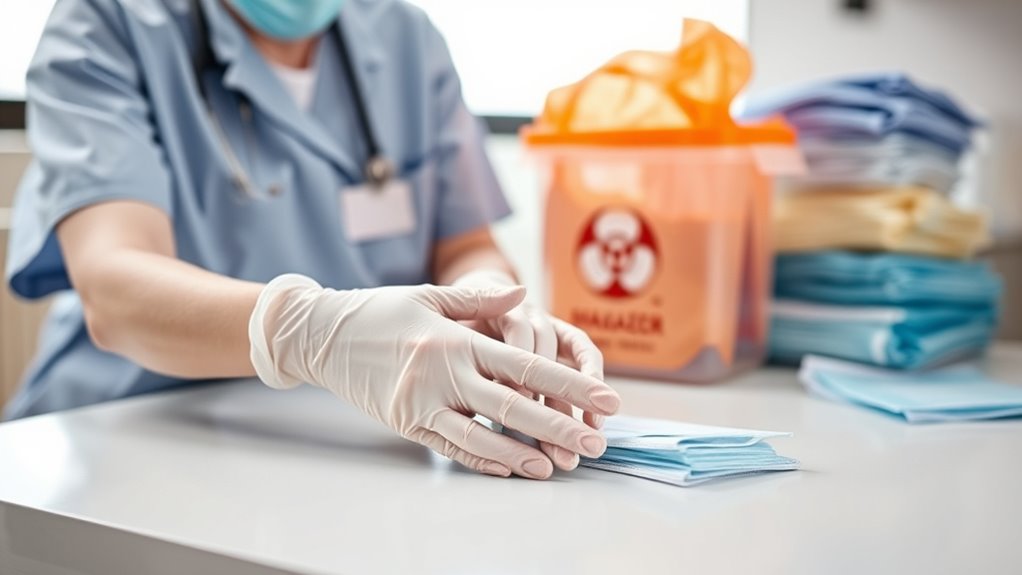
Using personal protective equipment (PPE) correctly is essential for protecting yourself and your patients from infection. Always wear the appropriate PPE for each task, and remove it carefully to prevent contamination. Proper PPE disposal is equally important; dispose of used equipment promptly in designated biohazard containers. Avoid touching your face during removal. After disposal, wash your hands thoroughly. Selecting the right PPE type for specific procedures helps ensure safety and effectiveness. Being aware of the safety features and proper maintenance of PPE, such as regular inspections, can further enhance infection control. Additionally, understanding industry trends and updates in PPE technology can help you stay current with best practices. Incorporating a self-watering plant system into your routine can also improve your attention to detail and promote safer practices.
Maintaining a Clean and Sanitized Environment

Maintaining a clean and sanitized environment is essential for preventing the spread of infections in care settings. Regular environmental cleaning involves wiping down surfaces, disinfecting high-touch areas, and ensuring floors are free of dirt and debris. Proper equipment sterilization is equally important; you should thoroughly clean and sterilize medical tools and devices after each use to eliminate germs. Use appropriate cleaning agents and follow manufacturer instructions to guarantee effectiveness. Consistent cleaning routines reduce microbial presence and create a safer space for both caregivers and those receiving care. Remember, a well-maintained environment not only minimizes infection risks but also promotes confidence and comfort for everyone involved. Prioritize cleanliness at all times to uphold high standards of hygiene and safety.
Safe Handling and Disposal of Waste
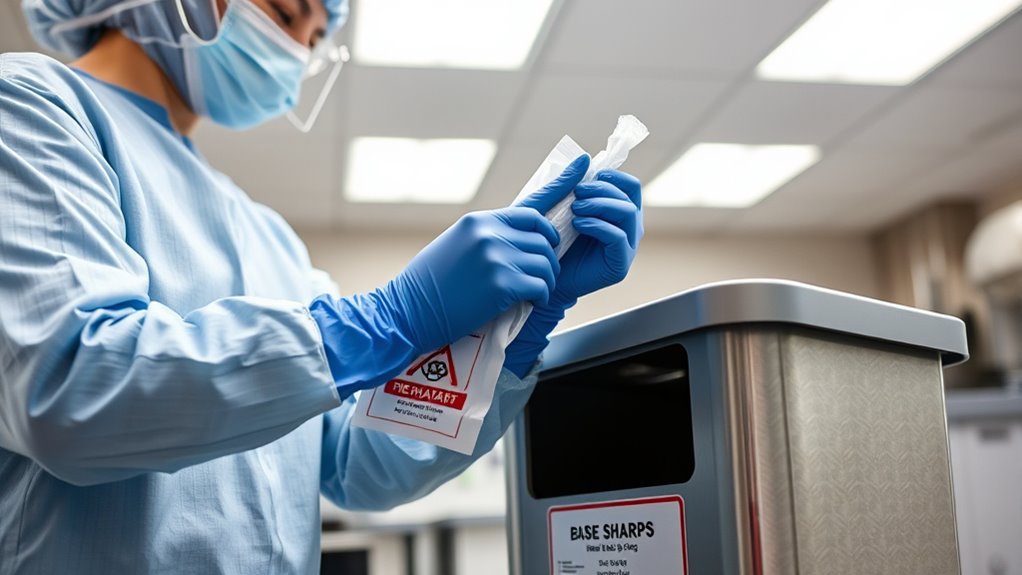
You need to follow proper waste segregation techniques to prevent cross-contamination. Make sure you understand disinfection and disposal procedures for different types of waste. By doing so, you protect yourself, your clients, and the environment from infection risks. Additionally, using appropriate waste disposal tools, such as filtration systems, can help ensure that hazardous materials are contained effectively. Implementing vetted waste management protocols is essential for maintaining a safe and hygienic environment in caregiving settings. Recognizing the horsepower of electric dirt bikes can also inspire innovative solutions for emergency response scenarios, where mobility and speed are critical. Incorporating best knitting patterns and techniques into your protocols can further enhance safety and compliance.
Proper Waste Segregation Techniques
Proper waste segregation is essential to prevent the spread of infections and protect everyone involved in caregiving. You must correctly separate waste types, using designated containers with clear waste labeling. Familiarize yourself with biohazard symbols to identify infectious waste easily. Always dispose of sharps in puncture-proof containers, and avoid overfilling bins. Proper segregation minimizes contamination risks and ensures safe handling. Here’s a quick guide:
| Waste Type | Container Labeling |
|---|---|
| Infectious waste | Biohazard symbols, red bags |
| Sharps | Puncture-proof containers |
| General waste | Regular waste bins |
| Chemical waste | Specific chemical labels |
| Non-infectious waste | Standard waste bins |
Disinfection and Disposal Procedures
To guarantee safety and prevent the spread of infection, caregivers must follow strict disinfection and disposal procedures when handling waste. Start by performing surface sterilization of work areas and tools to eliminate any remaining pathogens. Proper instrument decontamination is essential—immerse reusable instruments in appropriate disinfectants or sterilizers, following manufacturer instructions. Use gloves and protective gear when managing waste, and never reuse contaminated materials. Dispose of waste in designated, leak-proof containers, sealing them tightly before removal. Immediately clean and disinfect surfaces that contact waste to prevent cross-contamination. Always wash your hands thoroughly after disposal, and ensure waste is transported to authorized disposal sites promptly. Following these steps minimizes infection risks and maintains a safe environment for everyone involved. Regularly reviewing infection control protocols ensures caregivers stay up-to-date on best practices.
Recognizing and Managing Infection Risks

Identifying infection risks is crucial for effective infection control. You need to be alert to signs that could indicate a potential outbreak or the spread of antibiotic resistance. Recognizing these risks early allows you to take swift action to prevent infection transmission. Be aware of factors like:
- Unhygienic environments or contaminated surfaces
- Symptoms of infections in patients or yourself
- Improper use or disposal of medical supplies
- Close contact with infected individuals or contaminated materials
Managing these risks involves adhering to strict hygiene protocols, reporting concerns promptly, and supporting outbreak management strategies. Staying vigilant helps prevent infections from spreading and minimizes the impact of antibiotic-resistant bacteria, protecting both patients and caregivers.
Educating Care Recipients and Family Members
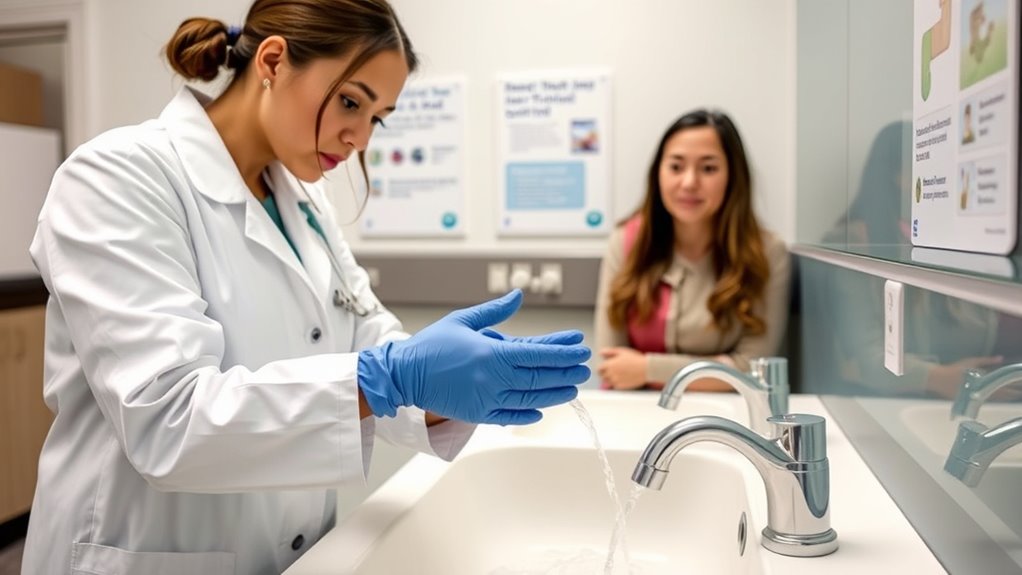
Educating care recipients and their family members is essential for effective infection control. You need to consider their cultural beliefs, which influence how they perceive hygiene practices and medical advice. Respecting these beliefs helps build trust and encourages cooperation. Use clear, simple communication strategies to explain the importance of handwashing, proper sanitation, and infection prevention measures. Demonstrate techniques when possible, and check for understanding by asking questions. Tailoring your messages to align with their cultural context ensures better engagement and compliance. Keep in mind that ongoing education reinforces good habits and reduces infection risks. Your role in providing this information empowers care recipients and families to take an active part in maintaining hygiene and safeguarding everyone’s health.
Frequently Asked Questions
How Often Should Caregivers Update Their Infection Control Training?
You should update your infection control training regularly to stay current. Healthcare guidelines recommend ongoing continuing education to enhance your skills and knowledge. Many certifications require renewal every 1-3 years, so stay on top of certification renewals to maintain your credentials. Keeping your training up to date guarantees you’re prepared for the latest practices, reduces risks, and provides safe, quality care to those you serve.
What Are the Signs of Ineffective Hand Hygiene?
You should watch for signs of ineffective hand hygiene, like persistent dirt or residue after washing. Poor handwashing techniques, such as rushing or missing key steps, can leave germs behind. Also, neglecting glove use protocols or touching surfaces without clean hands increases risk. If hands still feel sticky or look dirty, it’s a sign you need to improve your handwashing techniques and follow glove use protocols strictly to prevent contamination.
How Can Caregivers Prevent Cross-Contamination Between Patients?
Your efforts can stop a cascade of infections—think of it as preventing a wildfire. To prevent cross-contamination, always use personal protective equipment like gloves and masks when caring for different patients. Regularly practice environmental sanitation by disinfecting surfaces and equipment. Change gloves between patients, wash hands thoroughly, and avoid touching shared objects. These steps create a safe environment, stopping germs from traveling and protecting everyone under your care.
What Are the Protocols for Cleaning Medical Equipment?
When cleaning medical equipment, you follow strict sterilization procedures and equipment disinfection protocols to guarantee safety. First, thoroughly clean the equipment to remove any visible dirt or bodily fluids. Then, sterilize items using appropriate methods like autoclaving or chemical disinfectants. Always wear gloves and follow manufacturer guidelines. Properly storing sterilized equipment helps prevent contamination, maintaining a safe environment for patient care.
How Should Caregivers Handle Resistant or Unusual Infections?
Imagine facing a storm of antibiotic resistance and unusual infection patterns. As a caregiver, you must stay vigilant, recognizing signs that don’t fit typical patterns. You should isolate the affected individual, follow strict hygiene protocols, and consult healthcare professionals promptly. Properly use protective gear, document unusual symptoms, and guarantee thorough cleaning. Your swift, precise actions help contain resistant infections and protect everyone’s health, preventing the storm from spreading further.
Conclusion
Remember, in the world of infection control, your hands are the ultimate weapon—unless you forget to wash them, then they’re just dirty tools of chaos. Keeping everything sanitized and proper PPE habits might not make you a superhero, but it sure beats being the villain in an outbreak story. So, stay vigilant, educate others, and treat hygiene like your secret superpower—because in this game, cleanliness isn’t just next to godliness, it’s the only way to survive.
